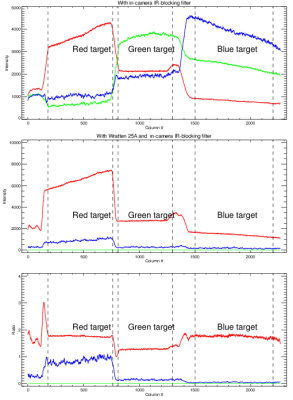I have performed some tests of color-separation on the Sigma SD10. The internal IR-blocking filter was present.
I imaged a red, green and blue surface with the camera as is; with the camera and a Wratten25A red filter; and with the camera and a 720nm long-pass IR filter.
Plotting a line across the three coloured surfaces (red at left, green in middle and blue at right), and separating the R G and B fields in the image file, we get:

We see
Top panel. No external filters, only internal IR-blocking filter. As
expected, the Red target is bright in the R-band of the image, Green in
the G band, and Blue in the B band.
Middle panel. Now the red Wratten 25A filter is on – i.e. it passes mainly
red light, up to about 560nm, or so. The R band is brightest on the Red target (good); the Green target is supressed strongly everywhere; the Blue band is brightest on the red surface.
Bottom panel. The ratios of panel 1 and 2. Note that exposure times were
not necessarily the same. In the R-band Red and Blue targets seem to have
fared similarly, but the Green target was suppressed by the W25A filter.
In the B-band the Red target was least suppressed by the W25A filter.
In the G band we see strong suppression by the W25A filter for all targets.
Summary: W25A really kills the Greens, but Blues seem to make it through
a bit. Strange that.
The long-pass 720nm filter performs similarly.
The tendency for the G band to ‘drop out’ is seen especially in images of point sources – streaks occur as if the presence of a point source is especially bad for the system. bad news for stellar photometry? We shall see.



